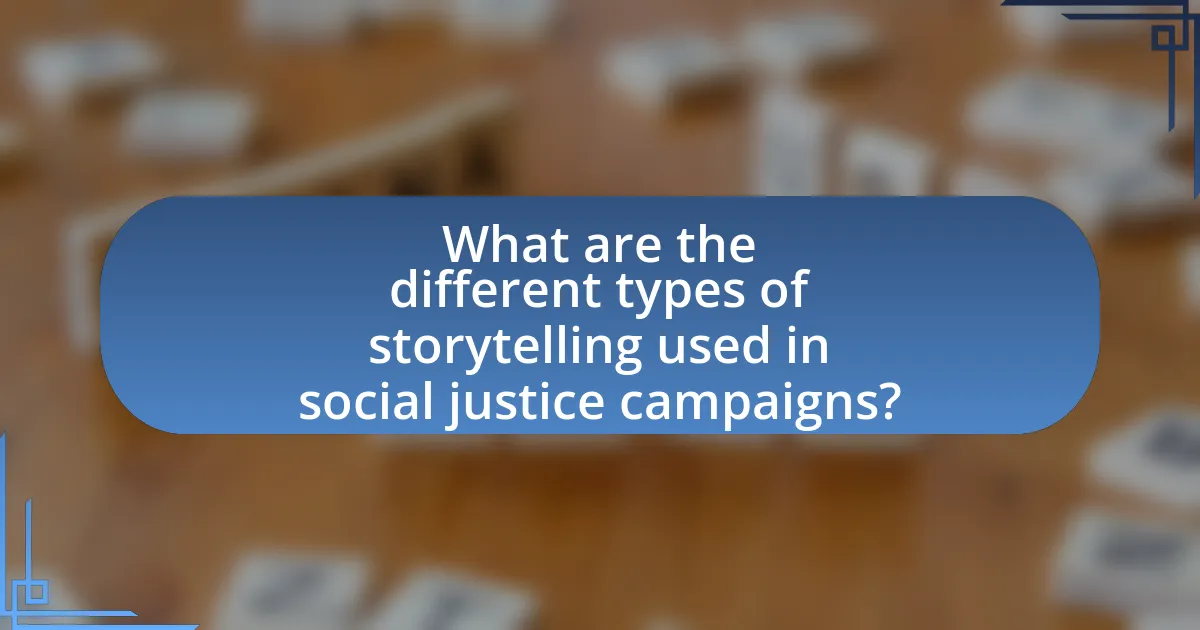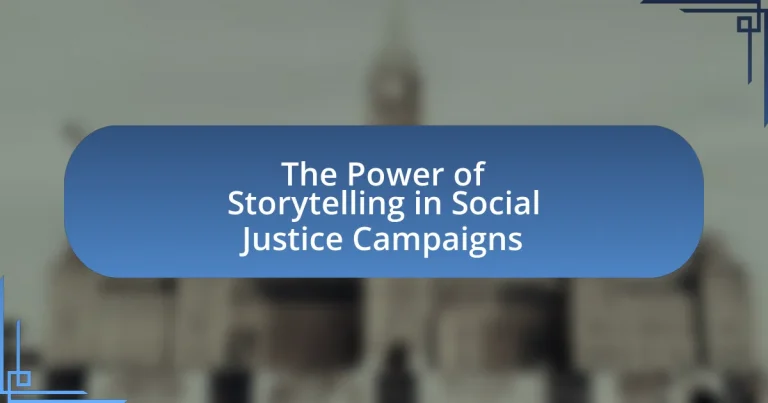The article examines the significant role of storytelling in social justice campaigns, highlighting its ability to humanize complex issues, evoke empathy, and mobilize action. It discusses how personal narratives, collective stories, and digital storytelling enhance engagement and understanding, ultimately driving social change. Key elements of effective storytelling, such as authenticity and emotional resonance, are outlined, along with strategies to avoid common pitfalls like oversimplification and misrepresentation. The article emphasizes the importance of emotional engagement in fostering solidarity and encourages the use of diverse perspectives to create impactful narratives that resonate with audiences.

What is the Power of Storytelling in Social Justice Campaigns?
The power of storytelling in social justice campaigns lies in its ability to humanize issues, evoke empathy, and mobilize action. Storytelling transforms abstract concepts of injustice into relatable narratives, making the experiences of marginalized communities tangible and urgent. For instance, campaigns like “Me Too” have effectively used personal stories to highlight the prevalence of sexual harassment, leading to widespread societal change and legislative reforms. Research indicates that narratives can increase engagement and understanding, as they activate emotional responses that statistics alone cannot achieve. This emotional connection fosters solidarity and encourages individuals to participate in advocacy efforts, demonstrating that storytelling is a crucial tool for driving social change.
How does storytelling influence social justice movements?
Storytelling significantly influences social justice movements by humanizing issues and fostering empathy among audiences. Through narratives, activists can convey personal experiences that illustrate systemic injustices, making abstract concepts more relatable. For instance, the #MeToo movement utilized personal stories to highlight the prevalence of sexual harassment, leading to widespread awareness and legislative changes. Research by the Stanford Social Innovation Review indicates that storytelling can increase engagement and mobilization, as it creates emotional connections that drive individuals to take action. Thus, storytelling serves as a powerful tool in shaping public perception and galvanizing support for social justice initiatives.
What are the key elements of effective storytelling in this context?
The key elements of effective storytelling in social justice campaigns include authenticity, emotional resonance, and a clear call to action. Authenticity ensures that the narrative reflects genuine experiences and voices, which builds trust and credibility among the audience. Emotional resonance engages the audience’s feelings, making the issues more relatable and compelling; studies show that emotionally charged stories are more likely to inspire action and empathy. A clear call to action provides direction, motivating the audience to participate or support the cause actively. These elements collectively enhance the impact of storytelling in advocating for social justice, as evidenced by successful campaigns that have mobilized communities and influenced policy changes.
How does emotional engagement enhance the impact of storytelling?
Emotional engagement significantly enhances the impact of storytelling by fostering a deeper connection between the audience and the narrative. When individuals emotionally resonate with a story, they are more likely to remember its message and feel compelled to act. Research indicates that emotionally charged stories can increase empathy and understanding, which are crucial in social justice campaigns. For instance, a study published in the journal “Psychological Science” found that narratives that evoke strong emotions lead to greater persuasion and behavioral change compared to neutral stories. This demonstrates that emotional engagement not only captures attention but also drives meaningful action in the context of social justice.
Why is storytelling essential for social justice advocacy?
Storytelling is essential for social justice advocacy because it humanizes complex issues and fosters empathy among audiences. By sharing personal narratives, advocates can illustrate the real-life impact of social injustices, making abstract concepts more relatable and urgent. Research shows that stories can significantly influence attitudes and behaviors; for instance, a study published in the journal “Science” found that narratives can change people’s perceptions and increase their willingness to support social causes. This emotional connection created through storytelling not only raises awareness but also mobilizes communities to take action, thereby amplifying the effectiveness of social justice campaigns.
What role does narrative play in shaping public perception?
Narrative plays a crucial role in shaping public perception by framing issues in a way that resonates emotionally with audiences. Through storytelling, complex social justice issues are simplified and made relatable, allowing individuals to connect with the experiences of others. For instance, narratives that highlight personal stories of marginalized communities can evoke empathy and drive public support for social change. Research by the Stanford Social Innovation Review indicates that narratives can significantly influence attitudes and behaviors, demonstrating that well-crafted stories can alter perceptions and mobilize action in social justice campaigns.
How can storytelling bridge gaps between diverse communities?
Storytelling can bridge gaps between diverse communities by fostering empathy and understanding through shared narratives. When individuals from different backgrounds share their experiences, it allows others to see the world from a different perspective, breaking down stereotypes and misconceptions. Research indicates that narratives can activate emotional responses, making listeners more receptive to new ideas and fostering connections. For instance, a study published in the journal “Science” found that stories can enhance the ability to empathize with others, leading to increased social cohesion. By highlighting common human experiences, storytelling serves as a powerful tool for uniting diverse groups and promoting social justice.

What are the different types of storytelling used in social justice campaigns?
Different types of storytelling used in social justice campaigns include personal narratives, collective stories, data-driven storytelling, and visual storytelling. Personal narratives focus on individual experiences to evoke empathy and connection, as seen in campaigns like “Me Too,” which highlights personal accounts of sexual harassment. Collective stories emphasize shared experiences within communities, fostering solidarity and collective action, such as the narratives used in the Civil Rights Movement. Data-driven storytelling utilizes statistics and research to present compelling arguments for social change, often seen in campaigns addressing issues like climate change or poverty. Visual storytelling employs images, videos, and graphics to convey messages powerfully and memorably, exemplified by campaigns like “Black Lives Matter,” which use striking visuals to raise awareness about racial injustice. Each type serves to engage audiences and drive action toward social justice goals.
How do personal stories contribute to social justice narratives?
Personal stories significantly contribute to social justice narratives by humanizing issues and fostering empathy among audiences. These narratives provide real-life contexts that illustrate the impact of systemic injustices, making abstract concepts more relatable. For instance, the storytelling approach used in campaigns like “Me Too” has effectively raised awareness about sexual harassment and assault, leading to widespread societal discussions and policy changes. Research indicates that personal testimonies can increase engagement and mobilization, as they evoke emotional responses that statistics alone often cannot achieve. This emotional connection is crucial for driving social change, as it encourages individuals to take action and advocate for justice.
What are the benefits of using personal testimonies in campaigns?
Using personal testimonies in campaigns enhances emotional connection and credibility, making messages more relatable and persuasive. Personal stories humanize issues, allowing audiences to empathize with the experiences of others, which can lead to increased engagement and support. Research indicates that narratives can significantly influence attitudes and behaviors; for instance, a study published in the journal “Health Communication” found that personal stories in health campaigns improved message retention and prompted action among audiences. This demonstrates that personal testimonies not only resonate on an emotional level but also effectively drive behavioral change.
How can personal stories create a sense of urgency for action?
Personal stories create a sense of urgency for action by humanizing issues and making them relatable, which compels individuals to respond. When people hear personal narratives, they often connect emotionally, leading to increased empathy and a desire to act. Research indicates that emotional engagement can significantly influence decision-making; for instance, a study published in the journal “Emotion” found that stories that evoke strong emotions can lead to higher levels of engagement and motivation to act. This connection between personal experiences and emotional response drives individuals to prioritize social justice issues, prompting immediate action.
What role does digital storytelling play in modern campaigns?
Digital storytelling plays a crucial role in modern campaigns by enhancing engagement and emotional connection with audiences. It allows organizations to convey complex social justice issues through relatable narratives, making the content more accessible and impactful. For instance, campaigns that utilize personal stories can increase empathy and drive action, as evidenced by the success of the “It Gets Better” project, which used video testimonials to address LGBTQ+ youth suicide. This approach not only raises awareness but also fosters community and mobilizes support, demonstrating the effectiveness of storytelling in achieving campaign goals.
How can social media amplify storytelling efforts?
Social media amplifies storytelling efforts by providing a vast platform for sharing narratives quickly and widely. This immediacy allows stories related to social justice to reach diverse audiences, fostering engagement and awareness. For instance, campaigns like #BlackLivesMatter have utilized platforms such as Twitter and Instagram to disseminate personal stories and experiences, which have led to increased visibility and support for social justice issues. Research indicates that visual storytelling on social media can enhance emotional connection, making the narratives more impactful and shareable, thus driving collective action.
What are the challenges of digital storytelling in social justice?
Digital storytelling in social justice faces several challenges, including issues of accessibility, representation, and the potential for misinterpretation. Accessibility challenges arise when marginalized communities lack the necessary technology or internet access to engage with digital narratives, limiting their participation. Representation issues occur when stories are told from perspectives that do not authentically reflect the experiences of the communities involved, leading to a dilution of the message. Additionally, misinterpretation can happen when audiences misunderstand the context or intent of the stories, which can undermine the social justice goals intended by the storytellers. These challenges highlight the complexities of effectively using digital storytelling as a tool for social justice advocacy.

How can storytelling strategies be effectively implemented in social justice campaigns?
Storytelling strategies can be effectively implemented in social justice campaigns by creating relatable narratives that resonate emotionally with the audience. These narratives should highlight personal experiences and struggles faced by individuals affected by social injustices, making the issues more tangible and urgent. For instance, campaigns like “Humans of New York” have successfully used personal stories to raise awareness about various social issues, demonstrating the power of individual narratives in fostering empathy and understanding. Research indicates that emotional engagement through storytelling can increase the likelihood of audience action, as seen in studies by the Stanford Social Innovation Review, which emphasize that stories can mobilize support and drive change by connecting people to the cause on a personal level.
What best practices should be followed for impactful storytelling?
To achieve impactful storytelling, one should focus on authenticity, emotional connection, and clarity. Authenticity ensures that the story resonates with the audience, as seen in campaigns like “Humans of New York,” which share real-life experiences that evoke empathy. Emotional connection can be fostered by highlighting relatable characters and situations, as demonstrated in the “It Gets Better” project, which effectively used personal narratives to support LGBTQ+ youth. Clarity in messaging is crucial; stories should have a clear structure and purpose, allowing the audience to easily grasp the core message, as evidenced by the success of the “Ice Bucket Challenge,” which combined a simple narrative with a clear call to action for ALS awareness.
How can organizations ensure authenticity in their narratives?
Organizations can ensure authenticity in their narratives by engaging directly with the communities they represent and incorporating their voices into the storytelling process. This approach fosters genuine representation and builds trust, as seen in the case of the “We Are All Human” campaign, which highlighted diverse personal stories from marginalized groups, ensuring their experiences were accurately portrayed. By prioritizing transparency and actively involving community members, organizations can create narratives that resonate authentically with their audience, thereby enhancing the impact of their social justice campaigns.
What techniques can enhance the reach of storytelling efforts?
Utilizing multimedia elements, such as videos and infographics, can significantly enhance the reach of storytelling efforts. Research indicates that incorporating visual content increases engagement rates, with studies showing that social media posts containing images receive 94% more views than those without. Additionally, leveraging social media platforms for storytelling allows for broader audience engagement, as platforms like Instagram and TikTok have billions of active users, facilitating the sharing of narratives across diverse demographics. Furthermore, employing emotional appeal in storytelling can resonate more deeply with audiences, leading to higher retention and sharing rates; a study by the University of Pennsylvania found that emotionally charged stories are more likely to be shared than neutral ones.
What are common pitfalls to avoid in storytelling for social justice?
Common pitfalls to avoid in storytelling for social justice include oversimplification, tokenism, and lack of authenticity. Oversimplification occurs when complex social issues are reduced to simplistic narratives, which can misrepresent the realities faced by marginalized communities. For example, portraying a social justice issue as a binary conflict can ignore the nuances and intersectional factors involved. Tokenism involves including diverse voices superficially without genuine representation or agency, which can perpetuate stereotypes rather than challenge them. Lack of authenticity arises when stories are told from a perspective that does not reflect the lived experiences of those affected, leading to narratives that feel disingenuous or exploitative. These pitfalls can undermine the effectiveness of social justice storytelling by alienating audiences and failing to foster meaningful engagement.
How can misrepresentation harm social justice efforts?
Misrepresentation can significantly undermine social justice efforts by distorting the narratives and experiences of marginalized communities. When stories are inaccurately portrayed, they can perpetuate stereotypes, misinform the public, and divert attention from the actual issues at hand. For instance, studies have shown that media misrepresentation can lead to public misconceptions about the prevalence of crime in certain communities, which in turn influences policy decisions and resource allocation. This distortion not only affects public perception but also hinders the ability of activists to advocate effectively for the rights and needs of those they represent. Accurate storytelling is essential for fostering understanding and empathy, which are critical for advancing social justice initiatives.
What strategies can prevent oversimplification of complex issues?
To prevent oversimplification of complex issues, employing a multi-faceted approach that includes diverse perspectives, thorough research, and narrative complexity is essential. Engaging various stakeholders ensures that multiple viewpoints are represented, which enriches the understanding of the issue. For instance, social justice campaigns that incorporate stories from affected communities provide depth and context, illustrating the nuances of their experiences. Research indicates that narratives that highlight individual stories alongside statistical data can effectively convey the complexity of social issues, as demonstrated in the work of scholars like Paul Slovic, who emphasizes the importance of personal connection in understanding large-scale problems. This combination of qualitative and quantitative data fosters a more comprehensive view, reducing the risk of oversimplification.
What practical tips can enhance storytelling in social justice campaigns?
Practical tips that can enhance storytelling in social justice campaigns include using personal narratives, engaging visuals, and clear messaging. Personal narratives create emotional connections, making the issues more relatable; for instance, sharing firsthand experiences of individuals affected by social injustices can evoke empathy and drive action. Engaging visuals, such as photographs or infographics, can capture attention and convey complex information quickly, as studies show that visuals increase retention of information by up to 65%. Clear messaging ensures that the campaign’s goals are easily understood, which is crucial for mobilizing support; research indicates that campaigns with concise and focused messages are more likely to succeed in reaching their target audience.


